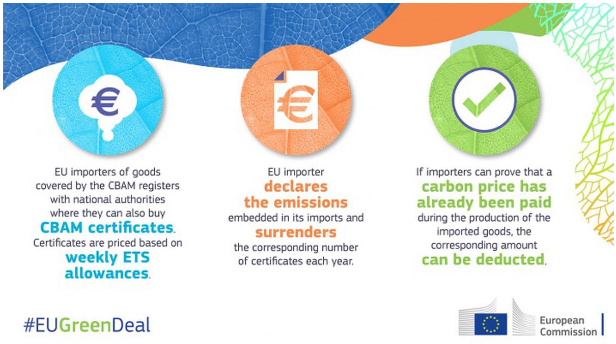Context:
Starting this October, the European Union (EU) proposes to introduce a framework for levying a carbon tax on imports of products that rely on nongreen or suboptimally sustainable processes and where carbon emissions are deemed to have not been adequately priced.
| Probable Question:
Discuss the need for developing countries including India to counter the Carbon Border Adjustment Mechanism of the EU. |
What is Carbon leakage?
- Carbon leakage is when companies, in order to meet climate policy requirements or to avoid restrictions on carbon emissions in their home country, relocate the production or manufacturing of carbon-intensive materials to countries with less stringent climate rules.
- This means that instead of getting sequestered, carbon emissions end up happening in another place.
- The EU contends that while it pursues emission reduction ambitions, the prevalence of weaker climate policies in other countries poses the risk of what is called carbon leakage.
What is the Carbon Border Adjustment Mechanism (CBAM)?
- In order to prevent carbon leakage and reach other climate change mitigation goals, , the EU in 2021, came up with a proposal for a Carbon Border Adjustment Mechanism (CBAM).
- The CBAM plans to impose a tariff on a set of carbon-intensive imports, which will have to be paid by EU importers and companies who export such goods to EU countries.
- With the CBAM, the EU also wants to create a level-playing field for business in the bloc with those outside by making equal the price for the carbon content of goods regardless of where they are made.
- The CBAM initially plans to impose a carbon border tax on the most carbon-intensive imports—iron and steel, cement, fertilisers, aluminium and electricity.

Opposition by India and developing countries:
- According to the Global Trade Research Initiative, the tax will translate into a 20-35% tariff on India’s exports of steel, aluminium and cement, which now attract an MFN duty of less than 3%.
- As much as 27% of India’s exports of steel, iron and aluminium products, or $8.2 billion, head to the EU.
- The impact is expected to rise as the EU adds more products to the CBAM list, leading to potentially billions in lost exports and increased costs.
- India has maintained that developed countries cannot push the burden of doing more to tackle climate change while they evade responsibilities themselves.
- India has stressed that ‘just transition’ to cleaner sources of energy did not mean that all countries should strive for the same level of decarbonisation.
- India may also flag the incompatibility with the UN’s climate change framework which moots common but differentiated responsibilities for developed and developing nations.
Measures needed:
- India’s role as a voice of Global South in G20: Having positioned itself as the voice of the global South, India must play that part to the hilt while at the helm of the G20 this year and galvanise other nations to take on the EU’s carbon tax framework.
- Implication of CBAM on Poorer Countries: This championing need not revolve around its own concerns, but the far worse implications the CBAM entails for poorer countries, many of whom rely more heavily on mineral resources than India.
- Consistency of environmental objectives with WTO principles: Environmental objectives should be consistent with the fundamental principles and basic rules of the WTO, strike a balance between environmental considerations and trade considerations, and not constitute protectionist measures or green trade barriers.
News Source: The Hindu
![]() 10 May 2023
10 May 2023
